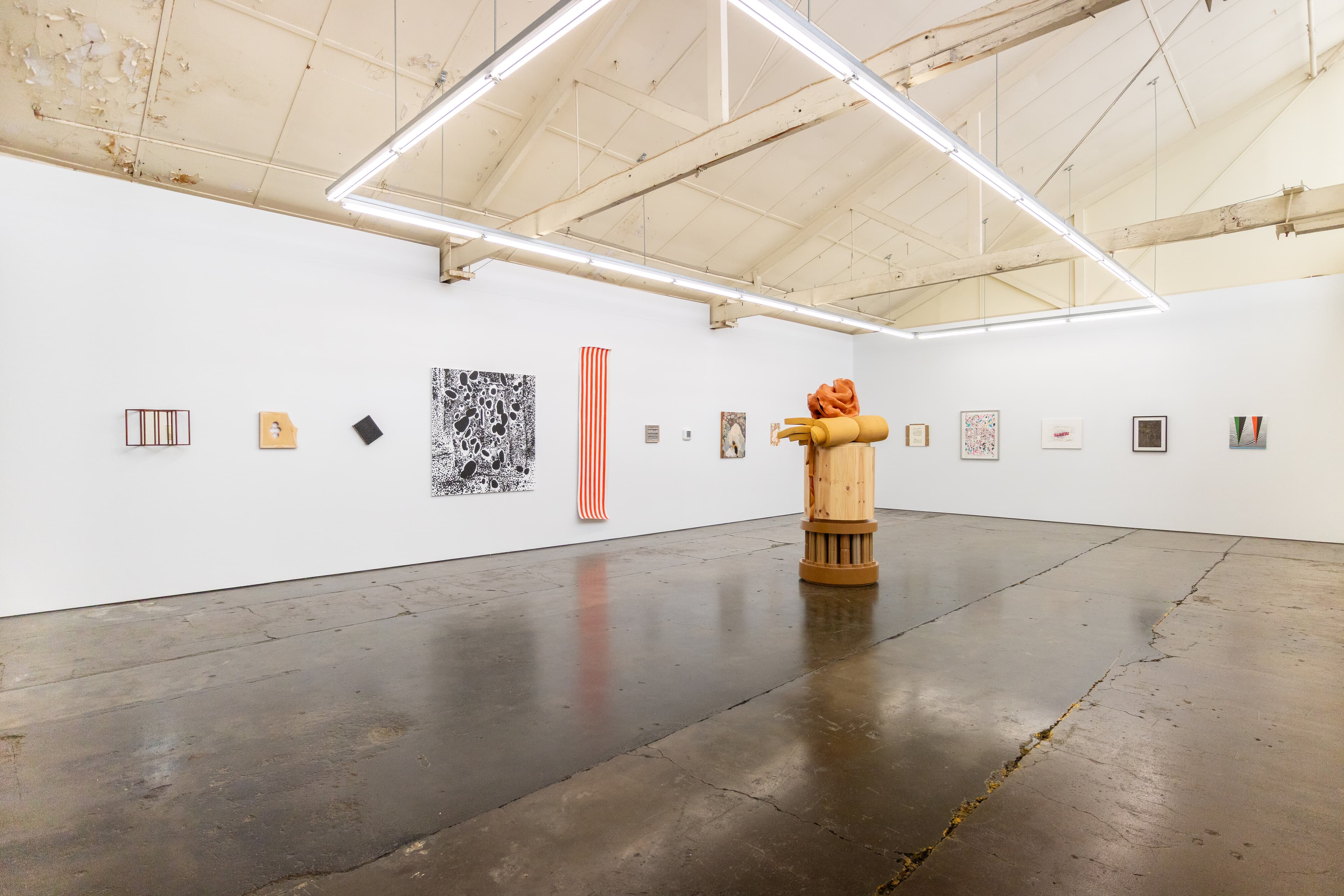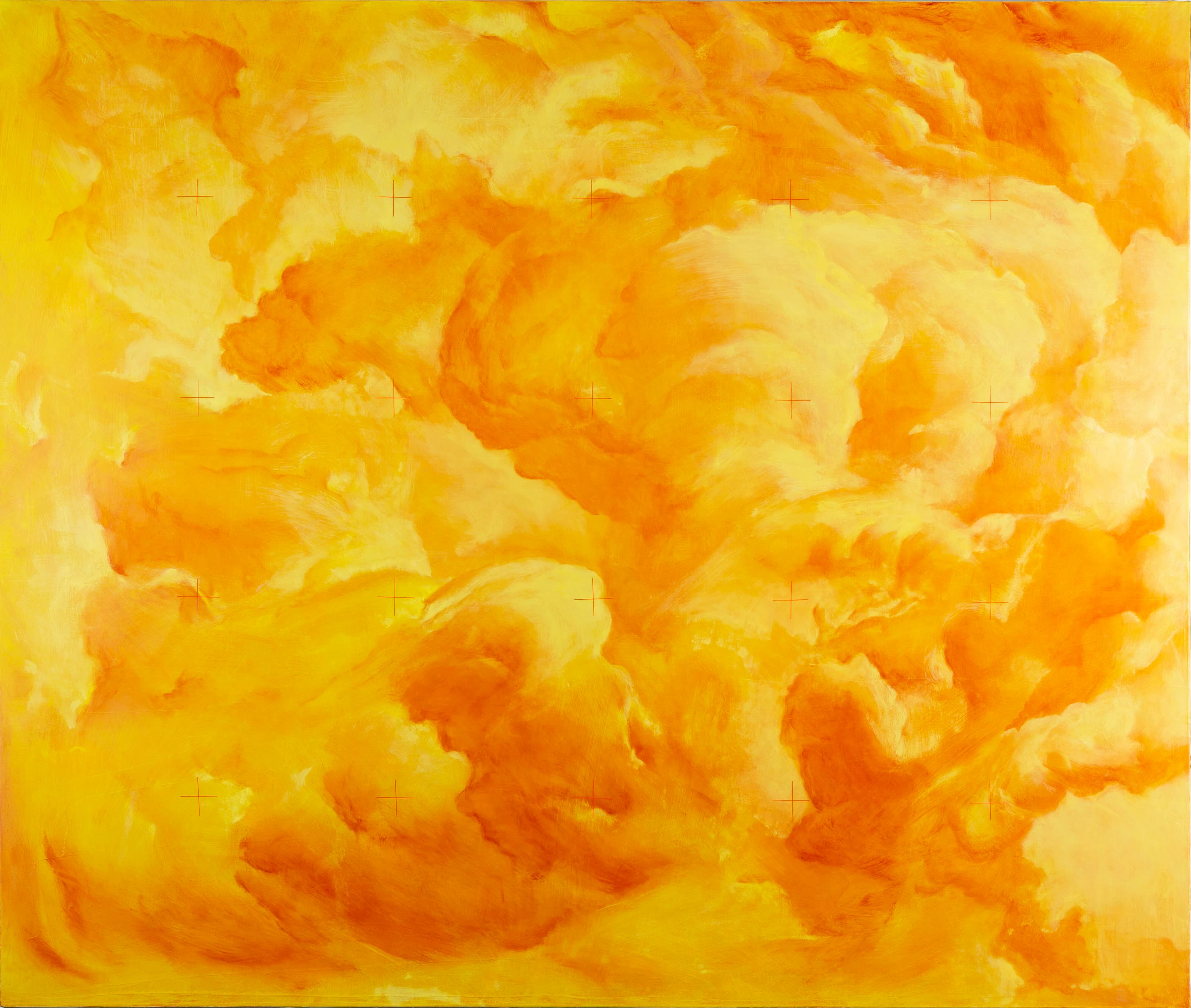Mia Boe, Thank you for your acknowledgement, can we have our land back now, 2025, acrylic on linen, Darebin Art Collection. Photo: Andrew Curtis
Taking Back Language
Juliet Day
Welcome ceremonies and Acknowledgements of Country are the latest vehicle for the Australian political culture wars. Peter Dutton declared them “overdone” and refused to stand behind the Aboriginal and Torres Strait Islander flags during his recent federal election campaign. In April, the Wurundjeri leader Aunty Joy Murphy was told she was “no longer needed” by Melbourne Storm for the NFL Welcome ceremony. Three weeks ago, members of the One Nation party turned their backs on the Acknowledgement in the senate. A ritual designed to be a display of respect has become a weapon of discrimination and symbol of prevailing injustice.
Language is a tool of power. So, too, is the ability to suppress language. Settler language, in the Australian context, was introduced as a means to discriminate, categorise, homogenise and remove First Nations people from history and the land. A lack of language in the form of truth-telling, treaty, and genuine reconciliation continues the colonial agenda. Referring to language in a literal sense, on this continent over half of all Indigenous languages have been decimated since colonisation. Taking Back Language, curated by Sarah Werkmeister and Katie Ryan at Bundoora Homestead Art Centre, understands language as a multi-faceted approach used by First Nations artists to reclaim, to speak back, and to challenge Western cultural dominance.
Amala Groom’s Does she know the Revolution is coming? (2017) holds pride of place as a new acquisition of the Darebin Art Collection. It’s the only artwork displayed on the ground floor. This nine-minute-long video piece is Groom’s hyperbolic retelling of a conversation she shared with a former Australian Prime Minister and his wife in their Manhattan home in 2015 (any guesses…? Wink wink, nudge nudge). Groom acts out all characters herself. The costuming choices are hysterical, with Groom appearing in multiple iterations of wispy blowouts and inappropriately coloured, tight-fitting blazers. It’s peak 2010s political fashion, affirming my choice to never wear a women’s blazer. The dialogue is similarly discomfiting.
“I do not understand why ‘Indigenous Australians’ are so angry!” says the Prime Minister’s wife.
“Did she think that ‘angry art’ was going to jump off the wall and go ‘er’?” Groom retorts.
As the video progresses, the PM’s wife continues making offensive remarks and generalisations about First Nations people and art. She says that the art on display “threatens the sanctity of nationalism,” that “Aboriginal culture only exists in remote desert communities,” and announces that she is “so rich.” She asks if anyone has seen her “Emily” (Kngwarreye). Groom hypothesises that she refrains from saying Kngwarreye because she can’t pronounce it.
Groom’s reenactment demonstrates how language is used to label, reduce, and homogenise First Nations communities and artists. “Indigenous Australians” as a catch-all term is critiqued for its homogenising and paternalistic effect. So-called “angry art” is positioned by prominent political figures as scary and working against a cohesive national identity. Utilising the flimsy defence of not being able to pronounce Kngwarreye’s surname, the Prime Minister’s wife diminishes the artist to a singular (Western) name. Subsequently, Kngwarreye’s identity is reduced to that of a decorative piece on a wall.

Production still of Amala Groom, Does she know the Revolution is coming?, 2017, six-channel digital video, dimensions variable, 09.56 mins, Darebin Art Collection. Production stills: Hamis Ta-mé
Upstairs, Taking Back Language is hung across three rooms. I’m drawn to the middle room, where Kait James’ tea towels beg for attention. James stitches over the top of 80s souvenir calendar tea towels that lean into the stereotypes of Indigenous people as “primitive” or “traditional” (this type of material has also been labelled “Aboriginalia”). James subverts settler language, Western pop culture references and humour to reveal the pervasive inequalities faced by First Nations communities and the domination of Western perspectives in Indigenous histories. Her tea towels are, on first look, playful and silly—kitsch neon embroidery depicts Twisties packets and Space Invaders. However, upon further examination, James’ works are devastating, highlighting the ongoing incarceration of Indigenous peoples, the mythologising of Captain Cook in Australian history and the continuing lack of meaningful recognition. Life is Pretty Shitty Without a Treaty.
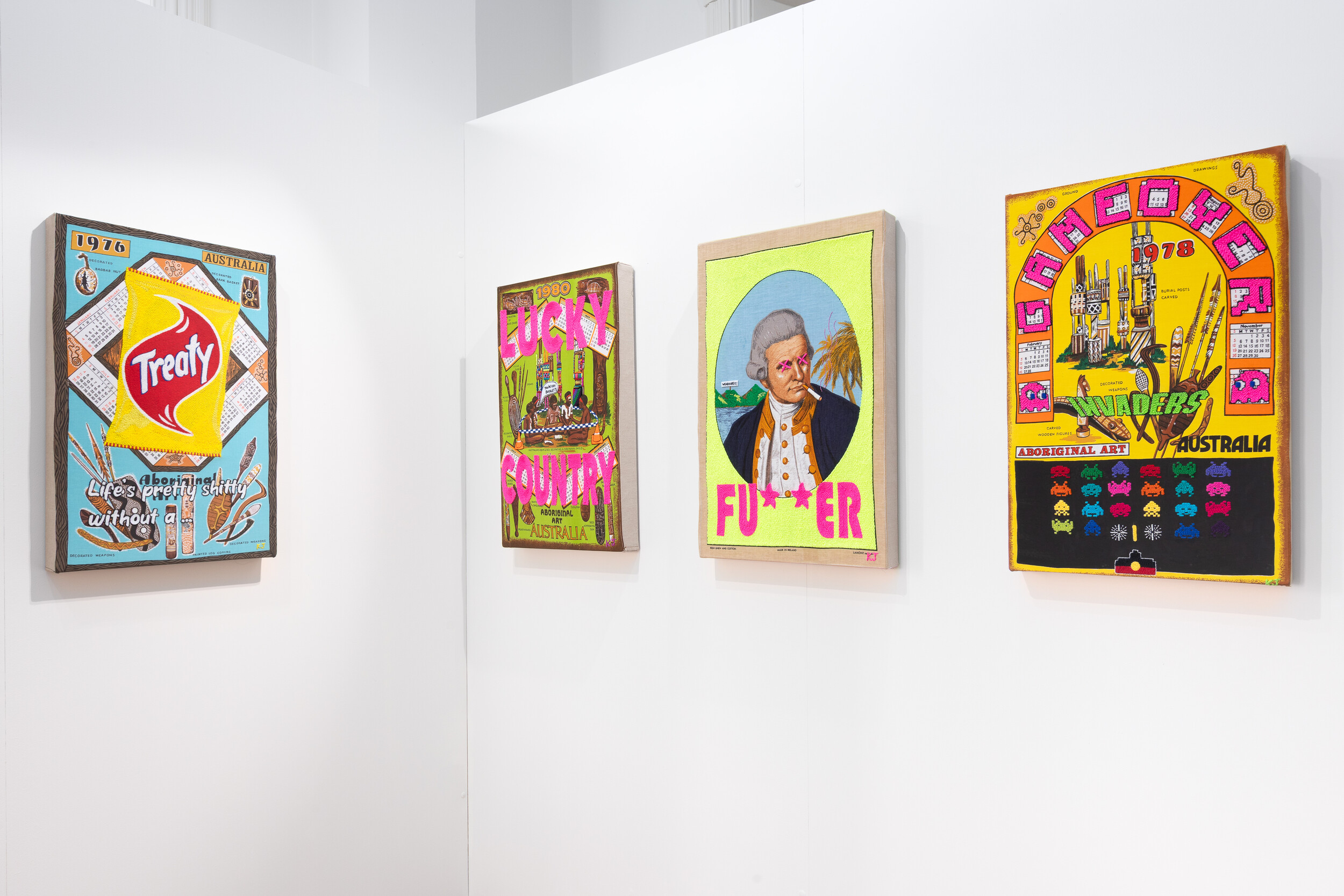
Installation view of Kait James. Left to right, Life’s Pretty Shitty Without a Treaty, 2020, wool, cotton, on printed cotton, Lucky Country, 2022, wool, cotton, on printed cotton, Captain Fu**er, 2021, wool, cotton, on printed cotton, Invaders Game Over, 2019, wool, cotton, on printed cotton, all courtesy of the artist. Photo: James Henry
The original tea towel used in Lucky Country (2022) represents a monolithic understanding of Indigenous culture. Art is a homogenous “Aboriginal art,” and described simplistically as “Ground Drawings,” “Decorated Weapons,” and “Carved Wooden Figures.” Indigenous men are depicted in the middle of the cloth, which James encircles in police tape and orange hazard cones. A speech bubble above one of the men’s heads reads “You’ve got Buckley’s”—a colloquial saying for “you’ve got no chance.” This settler language references British convict William Buckley, who sought refuge with Wadawurrung peoples after escaping penal settlement in 1803. After three decades, Buckley returned to the settler colony, becoming an interpreter for John Batman, and ultimately removed himself from the community once given a position of prestige in the colony. The reality is, Buckley did have a “chance.” He was saved by the Wadawurrung communities and then proceeded to reassimilate back into the colony easily. The use of the phrase “You’ve got Buckley’s” here is satirical. Amidst rising incarceration rates and widening inequalities, First Nations communities can’t just opt out, like Buckley. Western optimism understands the settlement and colonisation of Australia as an event of “good fortune,” but the myth of the “lucky country” conceals the lives of those who have cultivated it for centuries.
In direct contrast to James’ satire, Mia Boe’s Thank you for your acknowledgement, can we have our land back now (2025) is sobering. A string of repeated “I ACKNOWLEDGE” phrases are listed down Boe’s canvas. It feels cyclical, hollow—the words mean less the more they are repeated. There is a necessity of acknowledging Country, in ensuring recognition of specific First Nations communities as owners and custodians of the land, but as Boe points out, there remains a pain and triviality in such shallow acknowledgements. Those who acknowledge Country at large ceremonies and events are usually those that actively benefit the most from historic and ongoing dispossession. Acknowledgement on its own achieves little. Despite good intentions, language in the form of recognition and acknowledgement remains part of the larger colonial apparatus in contemporary society. The controversy surrounding Acknowledgments remains a farce—a veiling of the failed referendum, and one expression of the constant argy-bargy arguments impeding genuine change.
While James and Boe appropriate settler language to create biting commentary, other works in Taking Back Language revitalise Indigenous languages. Jenna Lee’s Words and Place Names (2022) is a series of framed page excerpts from Aboriginal Words and Place Names by A.W. Reed (1965). Utilising fire, Lee burns Gulumerridijin words into the pages in an act of returning language to Country through smoke. I’m reminded of Welcome to Country ceremonies held by Wurundjeri Woi Wurrung Elders and their communities. Smoke is important in cleansing, welcoming, and warding off bad spirits. Smoke and language are intertwined. Here, Lee’s burning is beautifully exact, with singular burnt holes forming each word. Each page is given explicit attention, framed individually, but the work is hung as a whole. A colonial artefact that homogenised diverse Indigenous languages under a Western archival lens is reclaimed and used as a device for sustaining the diversity of Indigenous language.
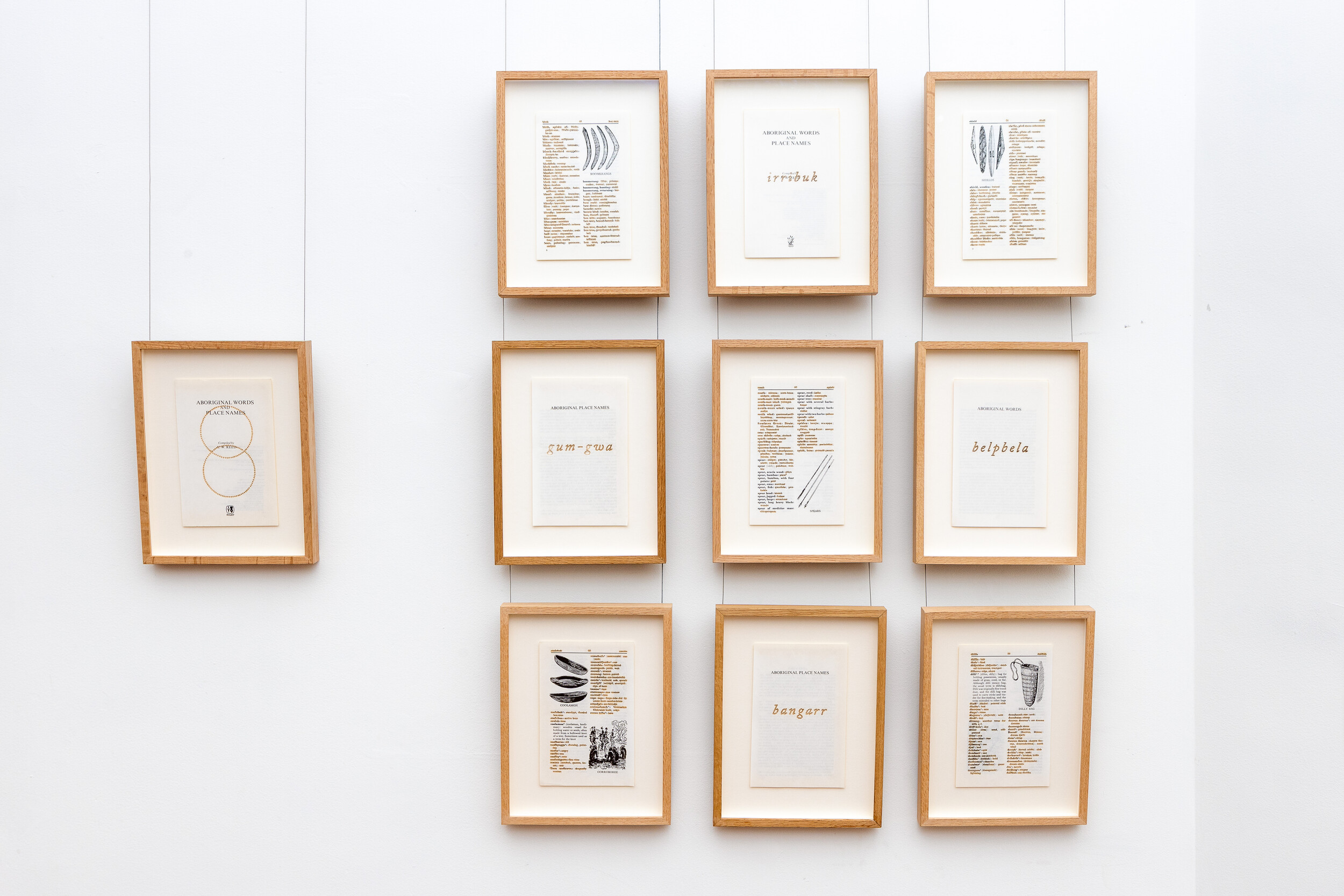
Jenna Lee, Words and Place Names, 2022, ‘Aboriginal Words and Place Names’, fire, courtesy of the artist and MARS gallery, Melbourne. Photo: James Henry
Peter Waples-Crowe represents language as everlasting and never lost. Karma Kunama (2017) is a representation of Waples-Crowe’s time spent with an Elder in the Ngarigo/Ngarigu community. Waples-Crowe dismantles the erasure of Ngarigo language and stories, using Kunama (or so-called Mount Kosciuszko) as the keeper, the “monument” that doesn’t forget. Kunama holds, and safekeeps, written, verbal, and embodied language. The mountain is constructed from a canvas layered with Ngarigo text, email cut-outs, magazine clippings, and a painted depiction of Waples-Crowe’s kin, the dingo. It’s like a treasure map. I scan the composition for ages, looking for Easter eggs. In the left side corner, an email excerpt is pasted down on the paint—a harsh, printed white set against the collaged work. It reads: “Dear Peter Waples-Crowe, thank you for your entry into the 34th Telstra National Aboriginal and Torres Strait Islander Art Awards. The standard of work received this year was exceptionally high. I regret to advise you that your artwork was not selected by the selection panel for this year’s Awards Exhibition.” Other collaged text reads “DIABETES” and “ENJOY YOUR TRIP.” Perhaps these messages are prophetic, foreboding, or communicating assigned predispositions. There is violence on the canvas, as figures appear bloodied in the far-right corner, yet ready for battle. The mountain remembers the violence of colonisation well. The swirling palette is ruddied, as hues of mustard, brown, and red amalgamate. Text is overlayed again and again, perhaps indicating the rewriting of history and the attempts to remove Indigenous languages. A process of constant rewriting and remembering is implied: “What goes around comes around. The mountain remembers.”
There is a juxtaposition between the works in Taking Back Language and the Homestead’s methods of display. Groom’s Does she know the Revolution is coming? conceptualises the display of work by Indigenous artists in homes as tokenistic and disingenuous. Ironically (or not?), Waples-Crowe’s Karma Kunama is hung above an ornate, carved wood fireplace. The Smith family, original tenants of the Homestead, would have once gathered here. Their maids would once have stoked the fire. The sound of Groom asking, “Have you seen my Emily?” permeates through to the second floor. Contemporary Aboriginal art remains a cultural passport by which affluent white buyers, politicians, and celebrities can purchase a perception of awareness and sensitivity. Groom’s voice is still audible: “I own a very expensive painting.”
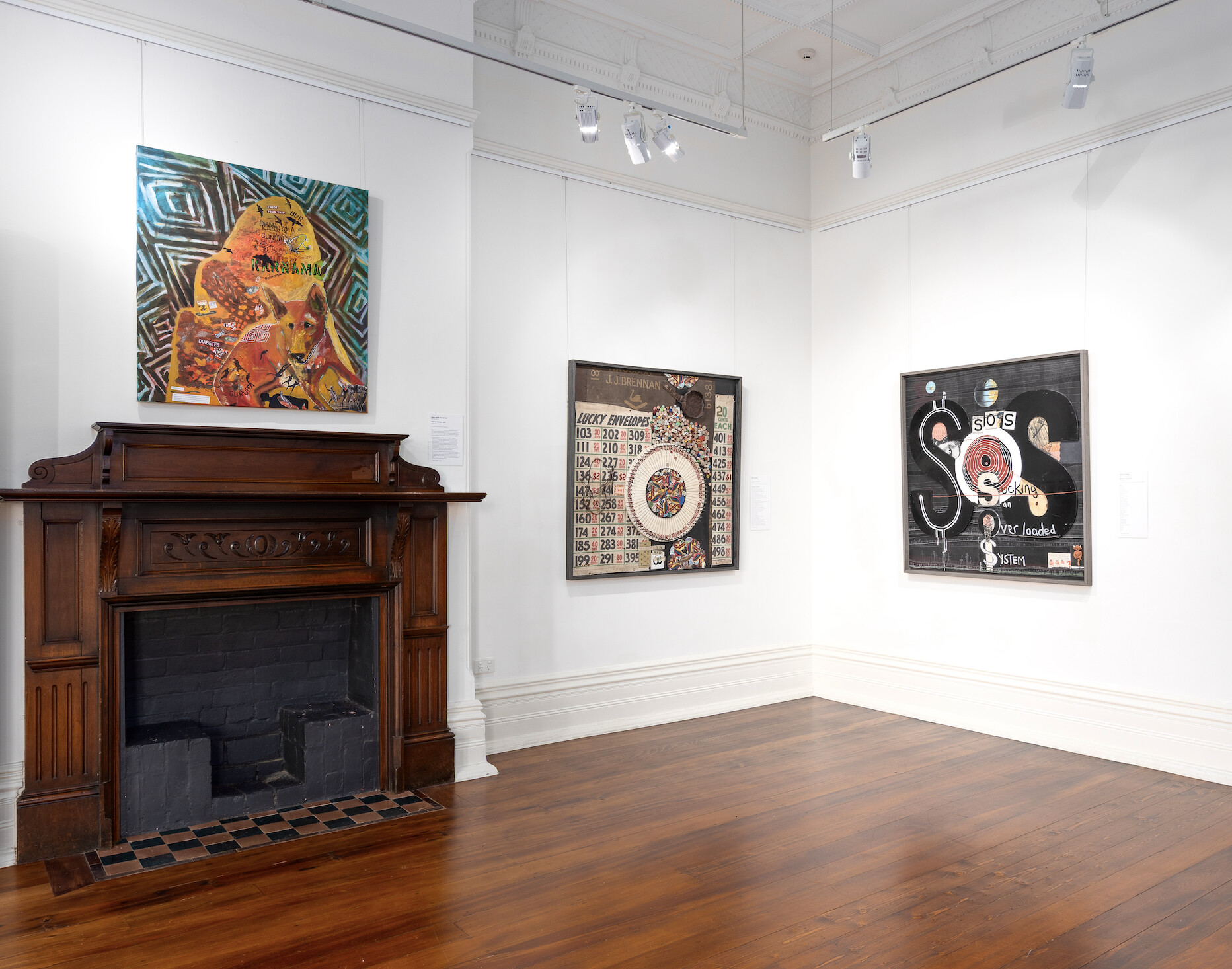
Peter Waples-Crowe, Karma Kunama, 2017, mixed media on canvas, courtesy of the Merri-bek Art Collection. Photo: James Henry
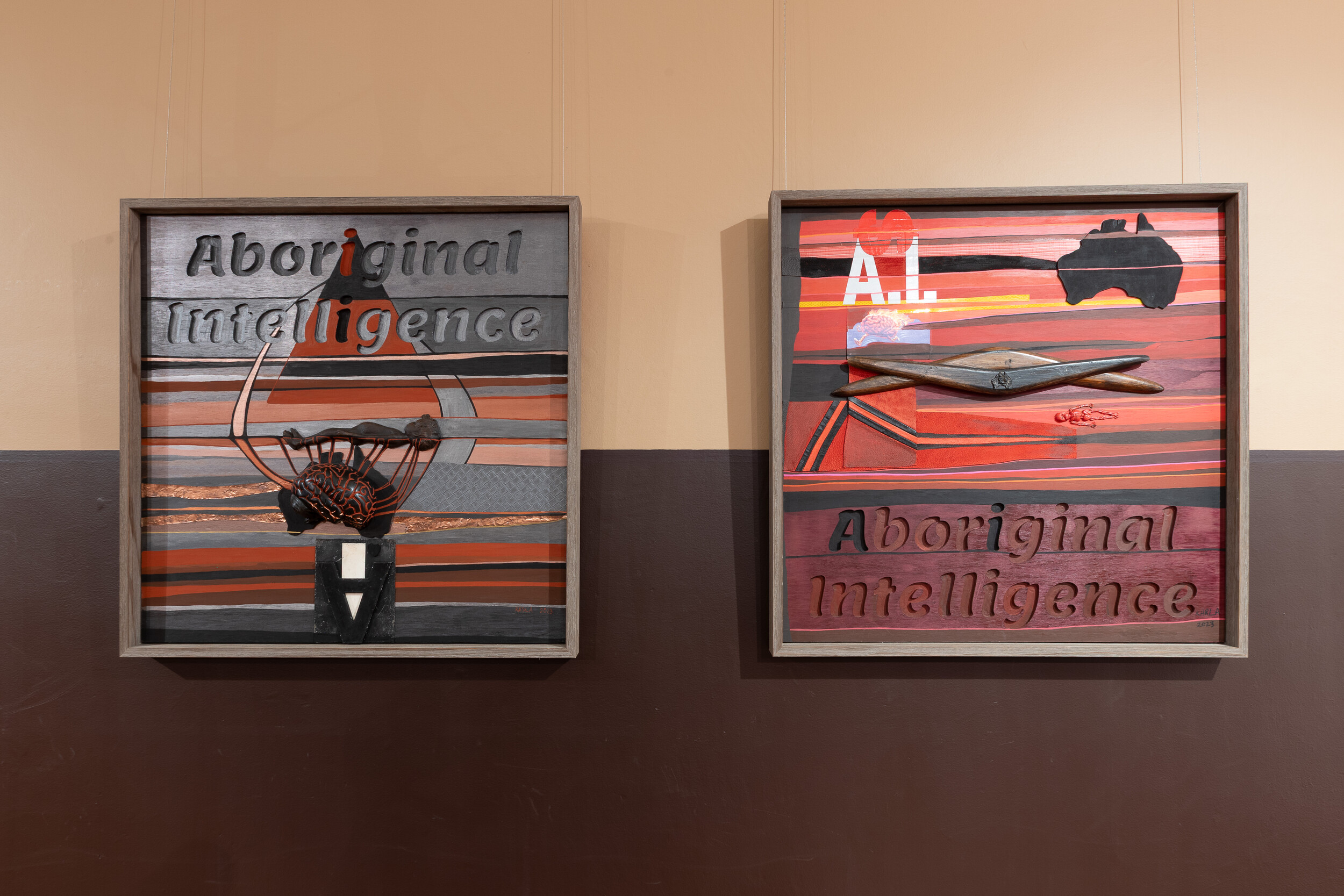
Installation view of Karla Dickens, AI 2, 2023, acrylic and mixed media on board and AI 4, 2023 acrylic and mixed media on board. Both courtesy of the artist and STATION Gallery. Photo: James Henry
Karla Dickens’ AI 2 and AI 4 (2023) places Artificial Intelligence and Aboriginal Intelligence (both “AI”) as oppositional, incongruent concepts. “Deep Learning” is a phrase used to describe how machines process information in a manner that resembles a human brain. Dickens contrasts this with the kind of “Deep Learning” that is rooted in oral histories and intergenerational practises central to Indigenous knowledge. Accompanied by poetry, Dickens understands Aboriginal knowledge as emotional, ancient, wise, complex, and embodied, while Artificial Intelligence is biased, mimicking, inauthentic, and, above all, artificial. AI 2 portrays a figure connected to a brain through rust-coloured strands. This brain is imposed over the Australian continent. Aboriginal Intelligence is positioned as an implicit connection to Country. It is literally deep-wired. AI 4 depicts a similar brain, though this time it is a printout flattened onto a board. I presume the brain is an AI-generated image, and it is running, fleeing the scene, on fire.
Calls to cancel or remove formal Acknowledgments of Country are also a way for Australian politics to flee the scene—to delay, to nit-pick, to unravel attempts at recognising sovereignty. Continuing with current Acknowledgements of Country, we package language neatly, a parcel of “we pay our respects” and “we recognise.” It can seem like applying a glossy sheen over continuing injustice. How can we use language to do more than just acknowledge?
Juliet is a writer based in Naarm/Melbourne.

